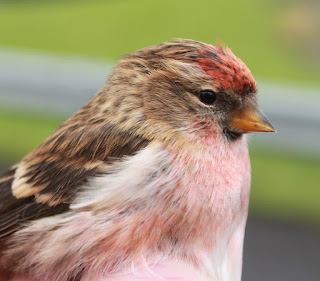At last, a break in the wind and rain allowed Andy and me to fit in a ringing session at Oakenclough on the edge of the Bowland Forest. With only a week to the shortest day our starts get later and 0815 today - three or four hours later than a typical start time during spring, summer or early autumn.
A quiet session saw us catch just 14 birds in 3 hours, slow going by any standards - 6 Coal Tit, 4 Goldfinch, 2 Lesser Redpoll, 1 Blue Tit and 1 Chaffinch.
Coal Tit
Although the weather of November and December has been wet and windy, the temperatures have been unseasonably high whereby there seems ample natural food for birds and not much reason for them to visit our feeding station, as evidenced today by the lack of Great Tits, Blue Tits and Chaffinches. Any Lesser Redpolls in the area now are winterers rather than migrants, the two today an adult male and a second year female found in the net together. When released they flew off in tandem.
Lesser Redpoll - adult male
Lesser Redpoll - adult male
Unlike today’s wintering Lesser Redpolls we received notification from the BTO of a same year spring to autumn recovery. Ring number Z312419, an adult male Lesser Redpoll was ringed here at Oakenclough on March 25th 2015. This bird was recaptured by other ringers on November 27th 2015 at Pelsall Common, West Midlands, and 247 days after the original capture. This is a typical spring to autumn capture sequence for this species but where the eventual destinations at each season are probably uncertain.
Lesser Redpoll - Oakenclough to West Midlands
Other birds we saw in the immediate area this morning - 2 Buzzard, 5 Mistle Thrush, 18 Goldfinch, 30+ Chaffinch.
On the way home via Nateby, Pilling and at a flooded field on Stalmine Moss, 72 Whooper Swans, a male Sparrowhawk, 1 Kestrel, 2 Buzzard.
Stalmine Moss
Whooper Swans
After a break in ringing during some six weeks it was good to finally achieve a hard won visit. Let’s hope that’s a good omen for the coming weeks.
Linking today to Anni's Birding and Eileen's Saturday and World Bird Wednesday.
Linking today to Anni's Birding and Eileen's Saturday and World Bird Wednesday.















































































